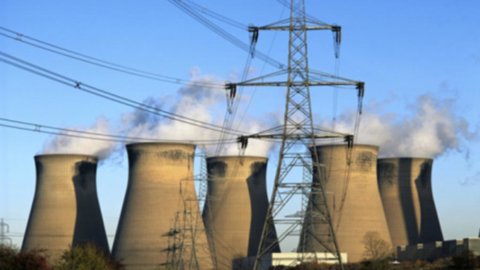The National Transmission Network (RTN) represents the backbone, the "circulatory system", of the Italian electricity system. In fact, it must ensure the importation and transport of electricity, at all times and in safe conditions, by connecting the production poles with the consumption centres. The more than 63.500 km of electricity lines that make it up are managed by Terna, a joint-stock company controlled by the State through Cassa Depositi e Presiti, which holds approximately 30% of the share package. The correct functioning of this impressive infrastructure and, therefore, of the electricity sector, requires continuous investments that allow the system to be kept in efficient conditions.
The importance of the NTG emerged in all its drama in 2003, when a series of supply interruptions (which affected the networks with foreign countries) and then the blackout which left the whole country in the dark, exposed the criticalities of the production system and of the national electricity transmission system.
To deal with this situation, since 2005 Terna has invested 7 billion euros in the electricity grid, building about 2.500 km of new power lines and 84 new stations. Among the most important works carried out we mention the “San Fiorano-Robbia”, “Matera-Santa Sofia”, “Laino-Rizziconi”, “Chignolo Po-Maleo”, “Turbigo-Rho” power lines and the “SA.PE.I. ”, the submarine cable that connects Sardinia to the continent. This has certainly made the electricity grid more modern and powerful, has guaranteed greater security to the electricity system and has made the market more competitive by reducing the infrastructural gap which separated Italy from the other European countries.
But the complexities and challenges are by no means finished. If it is true that the development of the electricity grid accompanied by important investments in electricity production facilities have had positive effects, it is also true that the economic and financial crisis is profoundly changing the structure of the Italian and also European electricity market. As described in the article published last September 21 on FirstOnLine signed by Marco Carta and Celeste Marino, the new challenges that the electricity sector must face in the coming years are:
-
drop in demand
-
reduction in electricity prices
-
development of renewables and Distributed Generation.
These challenges represent as many drivers that will necessarily guide investments in the network, as also highlighted in the National Energy Strategies (SEN).
Il drop in demand has created a clear situation of overcapacity in the country: with an installed capacity of around 120.000 MW, peak demand barely reaches 55.000 MW. This obviously makes investments in new production capacity superfluous. Conversely, the needs for the development and modernization of electricity networks remain relevant. This, at least for two reasons: firstly, by building the interconnection networks with foreign countries, part of the excess production could be sold to countries across the border; secondly, the increase in mesh size would make it possible to fully exploit the more efficient power plants which today operate on half-duty basis.
On the front of electricity prices, investments in the network would make it possible to remedy the problem of zonal markets and price differentials between the different areas of the country. In fact, due to bottlenecks in the national grid which do not always allow the most efficient plants to be exploited, there is not a single national electricity market, but several markets in which the price of energy can differ significantly. To date, the most significant bottleneck is between Sicily and Calabria: the price of electricity on the island is higher and generates a higher cost on the bills of all Italians of around 600 million euros a year.
Finally, looking at the impetuous development of renewable sources, investments not only in the grid, but also in transformation stations and accumulators, would make it possible to face and manage in an optimal way the large amount of intermittent energy fed into and to be fed into the grid. The "different programmability" (an expression that we fully agree with, coined by the president of the AEEG Guido Bortoni on the occasion of a conference on renewables held last September 20 at Bocconi) of wind and photovoltaic sources, in particular, generates critical issues on the distribution network but also on that of transmission which take the form of increases in congestion and related charges and in the use of less efficient production.
To face these challenges, Terna, in the 2013-2017 time horizon, intends to invest approximately 4,1 billion euros in order to:
-
develop, modernize and upgrade the electricity transmission grid, to make it more suitable for the needs of the "new" electricity system;
-
continue the plan for the modernization and rationalization of the electricity grid in the large metropolitan areas of Rome, Milan, Naples, Turin, Palermo and Genoa for a total investment of 1 billion euro;
-
create new electricity interconnections with foreign countries with the somewhat ambitious goal of making our country the electricity hub of the Mediterranean.
Various works are included in the Plan: the “Trino-Lacchiarella” power lines between Piedmont and Lombardy, “Dolo-Camin” in Veneto, “Foggia-Benevento” between Campania and Puglia, “Sorgente-Rizziconi” between Calabria and Sicily, “Feroleto- Maida” in Calabria and the interconnections with France, Austria and Montenegro. These infrastructures involve an investment of 2,7 billion euros destined to fall on the electricity bill that we all pay, even if it should be remembered that transmission accounts for only around 3% of the bill. For this reason it is absolutely necessary to ascertain the actual strategic importance of the indicated infrastructures; according to Terna's assessments they could generate significant benefits:
-
from an industrial and employment point of view, involving 210 companies and 340 workers on average engaged in construction site activities;
-
they will make it possible to demolish around 600 km of old power lines, returning large portions of land;
-
helping to reduce COXNUMX emissions into the atmosphere2 for over 1 million tons.
Our STUDIO 2012 of the “Costs of Non-Doing” Observatory highlights how failure to make investments to modernize the grid would cost the country around 6,8 million euros for each kilometer of power line not built, in terms of energy not supplied, higher costs of electricity, higher CO emissions2, higher network losses and alternative investments needed.
However, it should be emphasized that the new market conditions and the objectives set by the SEN require a careful re-evaluation and that, today and for the future, any additional investment is evaluated, planned and managed with great caution, certainly favoring those which allow effective savings on bills, also aiming at a careful optimization of expenses in the sense of "sobriety".
The “Sorgente-Rizziconi” power line
Among the works that certainly exceed any possible cost/benefit assessment with great impetus is the 380 kV “Sorgente-Rizziconi” power line designed to connect Sicily to the peninsula. The construction of the work, longed for too long and scandalously longed for, would guarantee certain benefits to the Sicily region in terms of reliability and cost of electricity, allowing security of supplies, avoiding blackouts, allowing the Sicilian electricity system to access the most efficient productions of the peninsula.
This work has been part of the National Electricity Grid Development Plan for over 10 years; after a long and difficult process, which lasted about 3 and a half years, it was authorized by the Ministry of Economic Development in 2010. Even today, despite being under construction, the work is still the subject of disputes by local administrations which in the past they had approved it, with very unconvincing reasons which, for the sake of the country, we will not dwell on.
Some numbers show the importance of the work. An investment of approximately 700 million euros and the employment of 90 firms and an average of 160 workers per day are foreseen for its construction. The submarine cable will be 38 km long, the longest in the world with alternating current. It will allow the most efficient production plants in southern Italy to compete with those in Sicily, resulting in a lowering of the price of energy on the island, generating savings estimated at approximately 600 million euros with an equivalent reduction in bills. Finally, from an environmental point of view, its construction would make it possible to demolish over 170 km of old power lines, to free 264 hectares of land from easement to the power line and to avoid CO emissions2 into the atmosphere for 670 thousand tons per year.
And what are we waiting for?





